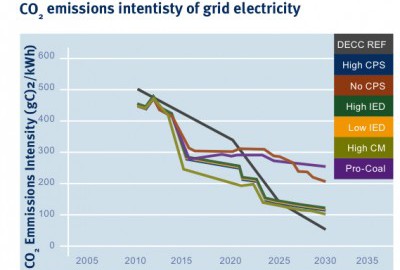If Great Britain wants to keep its carbon emission reductions on course, it’s going to need to make some significant policy changes.
That’s the word from a new report just released by London’s Imperial College. The researchers ran models of six likely scenarios for how Britain’s economy and carbon emissions could behave under current policy. The country’s Committee on Climate Change (CCC) has recommended that Britain get its emission rate — the amount of carbon dioxide released for every unit of energy produced — down to 50 grams of CO2 per kilowatt-hour (gCO2/kWh) by 2030. But in all six scenarios, the rate remained at or above 100 gCO2/kWh in that year.
The problem is the country’s coal generation. Great Britain has already closed 8 gigawatts (GW) of coal power, leaving 19 GW spread between nine plants. And in every scenario, at least 5 GW of coal-fired power remained in operation in 2030. These coal plants were mostly built back in 1960s and 1970s. They tend to be extremely dirty and inefficient, and rank among some of the biggest carbon emitters in all of Europe. The power sector also accounts for about half of the country’s total emissions.
In 2008, Great Britain passed the Climate Change Act, which established the CCC and legally committed the country to getting its greenhouse gas (GHG) emissions down to 80 percent below their 1990 levels by 2050. Subsequent legislation has created various tools for getting there, and empowered the Secretary of State to lay down an official target for the country’s power sector in 2016. For the moment, however, the CCC’s recommendation is the best goal post available.
The primary policy for hitting it is the European Union’s (EU) Emissions Trading System (ETS), a cap-and-trade program that includes Great Britain. But the country also has a Carbon Price Support (CPS) law, which sets a floor for how low the price of emissions on the ETS can drop within Britain’s market, and which rises over time. There are also regulations on emissions set by the EU as a whole, along with Britain’s own emissions performance standard (EPS) — which sets a rate limit for carbon emissions, but only for newly built power plants.
Read more: Climage Progress
